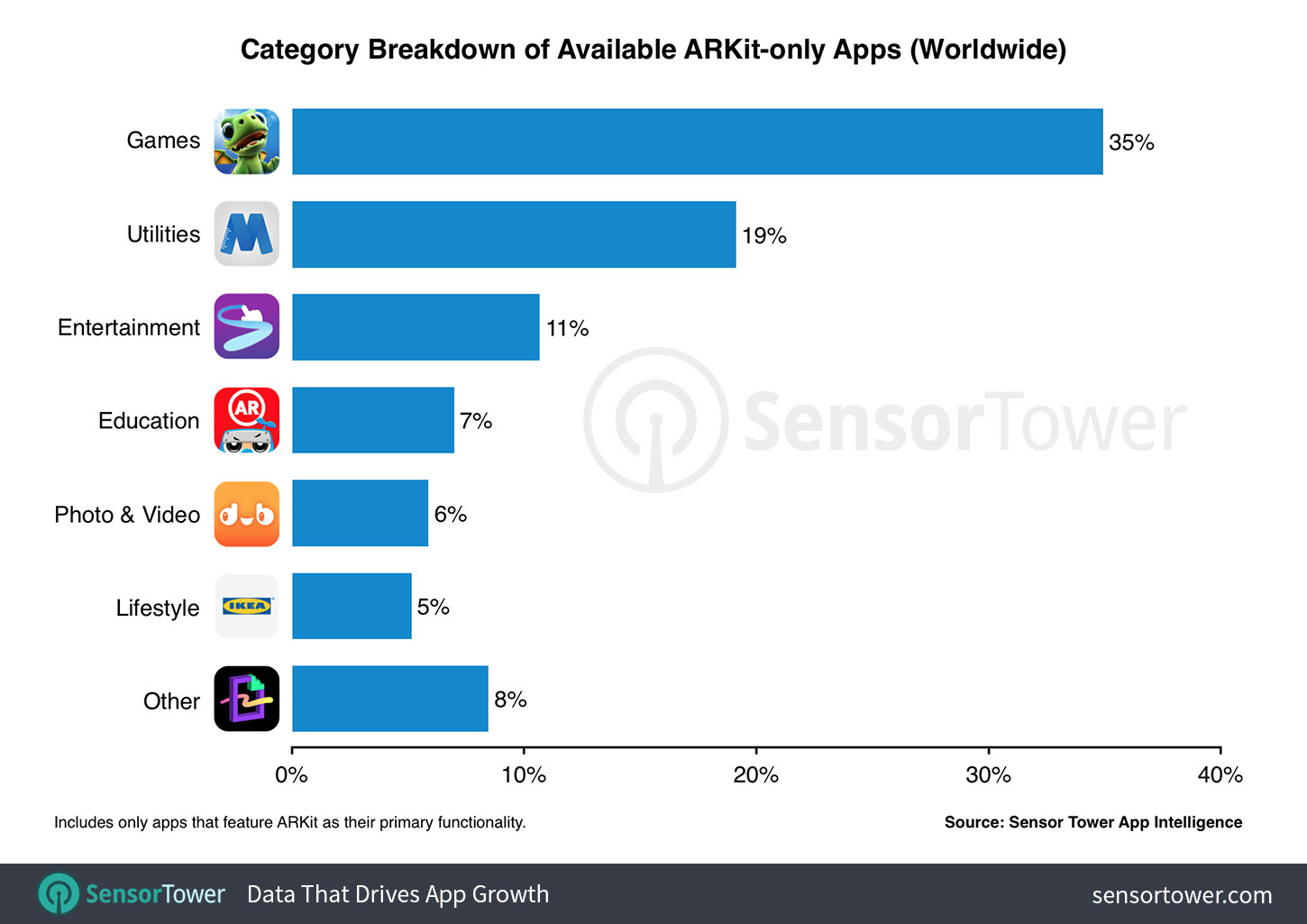 Ahead of its launch
Ahead of its launch, Apple's ARKit, which lets developers build augmented reality (AR) apps, was billed as a transformative new
technology for mobile devices. Meanwhile, Apple CEO Tim Cook has talked AR up whenever possible. Despite all that buzz, however, a new study shows that ARKit hasn't made a huge impact on how the app economy operates – at least, not yet. Sensor Tower, an intelligence firm that tracks apps for marketing purposes, has released a
study showing which apps and services are driven by ARKit. It tracked the overall AR-only app economy, as well as the top ten in each subject category. (One thing to note: the apps discussed rely exclusively on augmented reality; those "regular" apps with additive AR features aren’t factored in.) While much of the pre-launch buzz around ARKit focused on utility apps, games remain AR's main driver. Sensor Tower's study suggests 35 percent of augmented reality apps are games, while 19 percent are utility apps. (Overall, though, utility apps may be finding their footing;
App Annie notes that, in 2016, utility apps were ranked fifth for worldwide downloads.) [caption id="attachment_144363" align="aligncenter" width="1450"]

Games enjoy the bulk of AR downloads.[/caption] AR-boosted entertainment apps came in third, followed by education, photo and video, lifestyle, and "other." Games don’t dominate the AR scene completely, however. The top paid AR app is TapMeasure, a measuring tool, while AR MeasureKit, a similar tool, is number four on the ‘top grossing’ list. A healthy number of books and apps for kids also appear on these lists. So what's the takeaway here? Despite some great AR apps (and interesting use-cases), the economy surrounding AR doesn't seem all that different from the one around traditional apps: games still rule, although "productivity" and utility apps make a strong showing. (Not all utility apps are suited for AR, mind you; for example, there's probably little point in an AR document viewer.) Also, keep in mind that ARKit is only about one month old, and we’ve yet to see what impact Google’s
ARCore will have on the mobile AR space. Headsets may also surface new use-cases for AR (or make us want to use it more),
but those aren't anywhere near ready for mass consumption.
 Ahead of its launch, Apple's ARKit, which lets developers build augmented reality (AR) apps, was billed as a transformative new technology for mobile devices. Meanwhile, Apple CEO Tim Cook has talked AR up whenever possible. Despite all that buzz, however, a new study shows that ARKit hasn't made a huge impact on how the app economy operates – at least, not yet. Sensor Tower, an intelligence firm that tracks apps for marketing purposes, has released a study showing which apps and services are driven by ARKit. It tracked the overall AR-only app economy, as well as the top ten in each subject category. (One thing to note: the apps discussed rely exclusively on augmented reality; those "regular" apps with additive AR features aren’t factored in.) While much of the pre-launch buzz around ARKit focused on utility apps, games remain AR's main driver. Sensor Tower's study suggests 35 percent of augmented reality apps are games, while 19 percent are utility apps. (Overall, though, utility apps may be finding their footing; App Annie notes that, in 2016, utility apps were ranked fifth for worldwide downloads.) [caption id="attachment_144363" align="aligncenter" width="1450"]
Ahead of its launch, Apple's ARKit, which lets developers build augmented reality (AR) apps, was billed as a transformative new technology for mobile devices. Meanwhile, Apple CEO Tim Cook has talked AR up whenever possible. Despite all that buzz, however, a new study shows that ARKit hasn't made a huge impact on how the app economy operates – at least, not yet. Sensor Tower, an intelligence firm that tracks apps for marketing purposes, has released a study showing which apps and services are driven by ARKit. It tracked the overall AR-only app economy, as well as the top ten in each subject category. (One thing to note: the apps discussed rely exclusively on augmented reality; those "regular" apps with additive AR features aren’t factored in.) While much of the pre-launch buzz around ARKit focused on utility apps, games remain AR's main driver. Sensor Tower's study suggests 35 percent of augmented reality apps are games, while 19 percent are utility apps. (Overall, though, utility apps may be finding their footing; App Annie notes that, in 2016, utility apps were ranked fifth for worldwide downloads.) [caption id="attachment_144363" align="aligncenter" width="1450"]  Games enjoy the bulk of AR downloads.[/caption] AR-boosted entertainment apps came in third, followed by education, photo and video, lifestyle, and "other." Games don’t dominate the AR scene completely, however. The top paid AR app is TapMeasure, a measuring tool, while AR MeasureKit, a similar tool, is number four on the ‘top grossing’ list. A healthy number of books and apps for kids also appear on these lists. So what's the takeaway here? Despite some great AR apps (and interesting use-cases), the economy surrounding AR doesn't seem all that different from the one around traditional apps: games still rule, although "productivity" and utility apps make a strong showing. (Not all utility apps are suited for AR, mind you; for example, there's probably little point in an AR document viewer.) Also, keep in mind that ARKit is only about one month old, and we’ve yet to see what impact Google’s ARCore will have on the mobile AR space. Headsets may also surface new use-cases for AR (or make us want to use it more), but those aren't anywhere near ready for mass consumption.
Games enjoy the bulk of AR downloads.[/caption] AR-boosted entertainment apps came in third, followed by education, photo and video, lifestyle, and "other." Games don’t dominate the AR scene completely, however. The top paid AR app is TapMeasure, a measuring tool, while AR MeasureKit, a similar tool, is number four on the ‘top grossing’ list. A healthy number of books and apps for kids also appear on these lists. So what's the takeaway here? Despite some great AR apps (and interesting use-cases), the economy surrounding AR doesn't seem all that different from the one around traditional apps: games still rule, although "productivity" and utility apps make a strong showing. (Not all utility apps are suited for AR, mind you; for example, there's probably little point in an AR document viewer.) Also, keep in mind that ARKit is only about one month old, and we’ve yet to see what impact Google’s ARCore will have on the mobile AR space. Headsets may also surface new use-cases for AR (or make us want to use it more), but those aren't anywhere near ready for mass consumption. 


